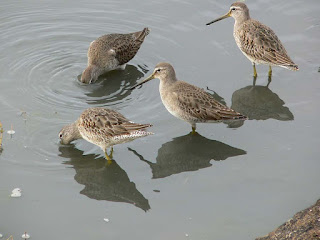Wednesday, January 10, 2018
Birding Bob Jone Trail and Beyond
Sunday - Avila Beach, Ca. - Bob Jones Trail - Mike Baird and I were standing on the foot, bike and golf cart bridge that crosses San Luis Creek hoping to see the Common Goldeneye, a sea-duck, native to the lakes and rivers of Canada, the northern U.S., Scandinavia, and Russia. (female on left) About three minutes after we arrived on the bridge the fog lifted. The Goldeneye were close and we got great views. They are a large duck and very beautiful. The male's eye is a bright orange; the female's eye is a soft golden color.
On either side of the bridge is the Avila Beach Golf Course where hundreds of Canada Goose, one Cackling Goose and multitudes of Coots were feeding on the grass. As we progressed up the trail, actually it is a road/trail for about a mile, we came upon an unusual sighting. A family of Western Bluebird were taking turns drinking from little pools of water that had accumulated on the yellow seats of a maintenance vehicle. (trail is above the maintenance yard) Two other birds of note, an Acorn Woodpecker perched atop a tall Red Cypress and a Great Blue Heron looking for edibles on a dry hillside.
Miscellaneous Sightings in the Great Beyond of Morro Bay
In a Eucalyptus tree a Turkey Vulture was doing her pre-flight warming exercise. At night the body temperature decreases. To fly they have to increase the body temperature. By spreading their wings, they increase the area the sun will be warming. The spread wing stance is called the "Horaltic Pose." Not only does the Pose dry the wings and warm the body, it also bakes off bacteria that forms on the legs from feeding inside a carcass.
Lately I have been fascinated by the movement of Ruddy Ducks. A couple thousand spend the winter on Morro Bay. They are always accompanied by a scattering of Greater Scaup. They are usually in a large spread out flock, appearing to be resting, but in motion. By expanding the photo you will notice the perky tail of the Ruddy and the bright white cheek of the male; upper left is a Bufflehead; the Scaup is the darker duck with the larger head.
Below is a Google Map that shows the location of the Avila bird sightings, from left to right - 1) X is where the Goose were located. 2) bridge over creek, Goldeneye, 3) Bluebirds, Woodpecker, 4) Great Blue Heron.
Monday, January 1, 2018
Audubon Overlook
Audubon Overlook. The day was tranquil - no one in sight; the melodious chatter of several hundred Black Brant Goose welcomed me. The tide was at a perfect level for viewing shorebirds, wading birds, and a variety of water fowl.
To the right was a flock of about 40 Long-billed Dowitcher, I think. When their bill is deep into the mud, up to and passed their nostrils sometimes, and they are at a distance, it is rather difficult to tell the difference between a Long-billed Dowitcher and a Short-billed Dowitcher; especially when the male Long-billed Dowitcher’s bill is the same length as the Short-billed Dowitcher’s bill. (photo taken near the Baywood Pier)
Taking advantage of whatever foods were abundant, four Green-winged Teal and a pair of Cinnamon Teal were feeding in shallow water along the shoreline. (male below)
Along the edge of the bay Willet, Godwit and one Black-bellied Plover; as the tide receded American Avocet and Northern Pintail appeared. In Morro Bay Pintail often feed by dabbling. They will also feed in fields eating rice, wheat, corn, and barley. Bottoms up!
Across the bay many Snowy and Great Egret accompanied by a few Great Blue Heron. Overhead low flying Forster’s Tern looked for small fish. They hover for a few moments before plunging into the water.
All of a sudden I noticed that the water was gone and so had the birds. As I experienced the magic of nature, I was unaware that time had passed.
Subscribe to:
Comments (Atom)











